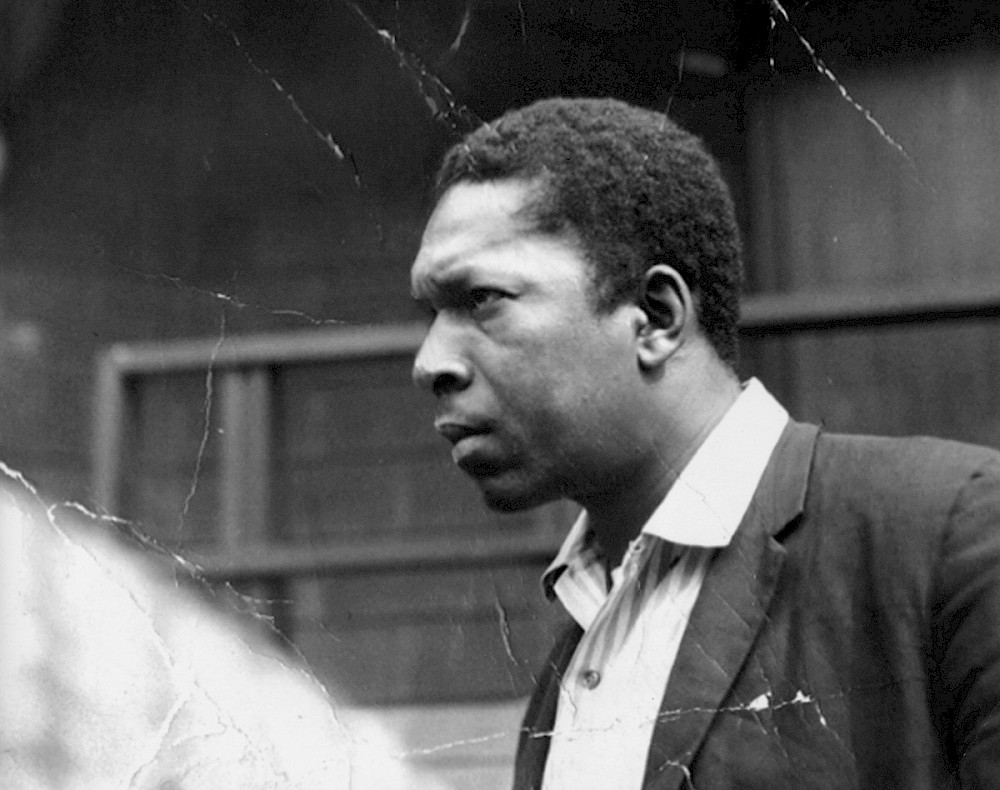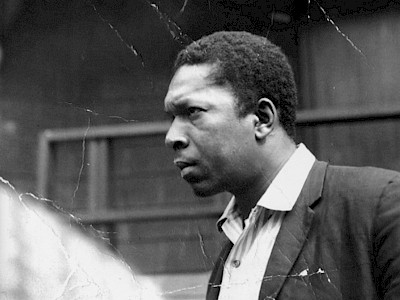24 — 28.05.2005
Anne Teresa De Keersmaeker is combining jazz and religious music. In a blend of improvisation and spirituality, her new creation – Raga for the rainy season/A love supreme – offers her dancers the joy of coming alive to the notes of Indian raga and John Coltrane. He has drawn inspiration himself from traditional Indian music which is a particular favourite of De Keersmaeker. The first part combines dance with Brahaspati’s voice to illuminate a raga and in the second, four dancers are invited to join Coltrane’s quartet. “I would like to discover a method so that if I want it to rain, it will start right away to rain. The true powers of music are still unknown.” (John Coltrane)
‘Nothing is so good as moving back and forth between the familiar and the unknown.’
Note on Indian ragas
Since her very first dance productions in the early Eighties, the work of Anne Teresa De Keersmaeker has been characterised by an exploration of the area of tension between movement and music. Over the last 20 years she has worked with a huge amount of extremely varied music. After concentrating in her first few pieces exclusively on Minimal music by such composers as Steve Reich, she later took on such 20th-century composers as Béla Bartók and György Ligeti, but also concert arias by Mozart or, more recently, music by Purcell. For the last few years she has been increasingly fascinated by two other musical genres: Indian ragas and jazz. Her first encounter with jazz on stage took place during In real time (2000), a theatre-dance production by Rosas and Tg. Stan, with live music by the contemporary jazz group Aka Moon. Indian ragas turned up for the first time in but if a look should) April Me (2002).
Two years ago De Keersmaeker surprised us with Bitches Brew/Tacoma Narrows, a choreography based on the composition by the jazz legend Miles Davis. It was not without reason that in this music the choreographer explored the possibility of improvisation and its interaction with fixed structures. Jazz is after all the one form of music in which structure and improvisation go most harmoniously hand-in-hand.
Bitches Brew was the first Rosas production in which improvisation formed an intrinsic part of the artistic product. During this process De Keersmaeker received support and feedback from Salva Sanchis, one of the first dancers to graduate from P.A.R.T.S., and who then followed his own course as a choreographer. The two choreographers found they had something in common in their shared fascination for jazz music and their exploration of the potential of improvisation. Salva Sanchis’ choreographic contribution grew, which resulted in the recent co–choreography of Desh (the second part of the night). For the first time in her career as choreographer and dancer, De Keersmaeker experienced it as a challenge to work together on choreography, and herself to dance material which another choreographer had in part written for her. Just as in Bitches Brew, the further possibilities of improvisation were explored in Desh, but this time not only in jazz but also in Indian ragas. The relationship between composition and improvisation, and between the familiar and the unknown, is also at the heart of these ragas.
The new performance, Raga for the Rainy Season / A Love Supreme, is in two parts: Raga for the Rainy Season is for nine dancers – eight women and a man – who perform a series of variations to the music of an Indian raga for the rainy season. A Love Supreme is a quartet in which two men and two women dance to this legendary piece of music by John Coltrane. The two works have completely different atmospheres, but at the same time share a common notion of spirituality.
The Indian Mian Malhar raga, a Raga for the rainy season, sung by Sulochana Brahaspati, is a musical prayer on the melancholy brought about by the rain and by waiting. The various stages of waiting while it rains outside take the form of a horizontal experience of time, time stretched out, stillness and meditation. The movements are languorous, performed with a subdued, inward-looking concentration; bodies carry and are carried, dancers move in a unison which then breaks up, drifts apart; the little rituals from the daily lives of the waiting women can be seen in the stretched-out movement material, which is occasionally injected with a quick staccato, a desperate falling and getting up, followed by consolation. Because this waiting arouses resistance, and the linear slowness is disrupted by passionate rebellion. Each individual breaks out of the endless flow of emotions and movements in her own way. The linear choreographic pattern is interrupted by circles and spirals, and the dancers are like heavenly bodies in the universe, alone and yet linked together in a perfectly organised chaos.
Each movement is fixed, in an obsessional pattern of structures and compositions, even though it does not seem to be so. By contrast, in the second part, A Love Supreme, there is more space than ever for ‘instant composition’, for the unexpected and the unforeseen. Whereas in such past productions as Bitches Brew and Desh a clear distinction still remained between those sequences composed in advance and those which were improvised, the challenge in A Love Supreme is to truly bring improvisation and composed material together, to interweave them and to let them become absorbed in one another.
How do you take the tension between structure and freedom that is so natural in jazz music and convert it into dance? How does a group of dancers organise itself spontaneously during a performance? And how is the individual related to the group in this delicate relationship between planned structure and instant decision-making? How do you tell your story, as a group, as an individual? And how do you underpin each others’ stories? All these questions formed the starting point for the two choreographers’ quest for improvisation as a dance idiom. Improvisation consists of the balance between ‘making rules’ and ‘finding freedom’. Now that this challenge of improvisation has been taken up more than ever before, the importance of underlying structural principles becomes that much greater. De Keersmaeker has always been fascinated by patterns that organise time and space, series of numbers or spirals, that imply an endless way of constructing space and then deconstructing it again. When starting from improvisation these fixed points are more important than ever.
De Keersmaeker and Sanchis have had Coltrane’s A Love Supreme in their minds for several years now, and have been rather hesitant about actually using it as dance music. In this small group of four dancers – Cynthia Loemij, Moya Michael, Salva Sanchis and Igor Shyshko – the performance is at the same time emphatically borne along by the dancers. A Love Supreme is one of the highlights of 20th-century jazz and is remarkable for the tension between complexity and simplicity, a tension that has always characterised De Keersmaeker’s choreography too.
A Love Supreme is John Coltrane’s ultimate spiritual statement. No one has taken the technical exploration of an instrument so far with the aim of reaching ‘spiritual heights’. The piece comprises four parts: Acknowledgement, Resolution, Pursuance and Psalm. It ends with an ecstatic poem by Coltrane – an ode to divine love. The piece displays simplicity and complexity, an absolute beauty which is also closely tied up with the performance (John Coltrane, McCoy Tyner, Jimmy Garrison and Elvin Jones).
It is no coincidence that the contrast between the Raga for the Rainy Season and A Love Supreme is the contrast between the horizontal and vertical, the female and the male voice, the monophonic and polyphonic. These balancing opposites have always been the underlying motivation behind De Keersmaeker’s creative drive.
The two pieces are both complementary and opposite: the drawn-out energy and the horizontal stretching of time in the raga contrasts with the compactness and verticality of Coltrane’s A Love Supreme, in which the ever higher transcendental movement is so moving. The restrained melancholy of the slowness in the raga is just as passionate as the intensity of the four individuals with their distinct motives in A Love Supreme. Both pieces display an extreme formal logic that is intended to generate beauty and emotions. It is this emotional approach which in the work of Anne Teresa De Keersmaeker repeatedly transcends the purely formal choreographic exploration, and makes every dancer involved both strong and vulnerable.
Sigrid Bousset
Raga for the rainy season
Choreography: Anne Teresa De Keersmaeker
Music: Raga Mian Malhar (sung by Sulochana Brahaspati)
Dance: Marta Coronado, Fumiyo Ikeda, Kaya Kolodziejczyk, Elizaveta Penkóva, Zsuzsa Rózsavölgyi, Taka Shamoto, Clinton Stringer, Giulia Sugranyes, Rosalba Torres Guerrero
A Love Supreme
Choreography: Anne Teresa De Keersmaeker & Salva Sanchis
Music: A Love Supreme (John Coltrane: tenorsax, vocals - McCoy Tyner: piano - Jimmy Garrison: bass - Elvin Jones: drums)
Dance: Cynthia Loemij, Moya Michael, Salva Sanchis, Igor Shyshko
Set and Light: Jan Versweyveld
Costumes: Dries Van Noten
Production: Rosas & De Munt/La Monnaie (Bruxelles/Brussel)
Coproduction: Théâtre de la Ville (Paris), Opéra de Rouen/Haute Normandie, het Teatro Comunale di Ferrara
Supported by: Monnaie Foundation
Rosas is subsidised by the Ministerie van de Vlaamse Gemeenschap, is supported by the Belgian Lottery, is company in residence at the Royal Opera, Brussels
Presentation: La Monnaie/De Munt, Les Halles de Schaerbeek, KunstenFESTIVALdesArts


